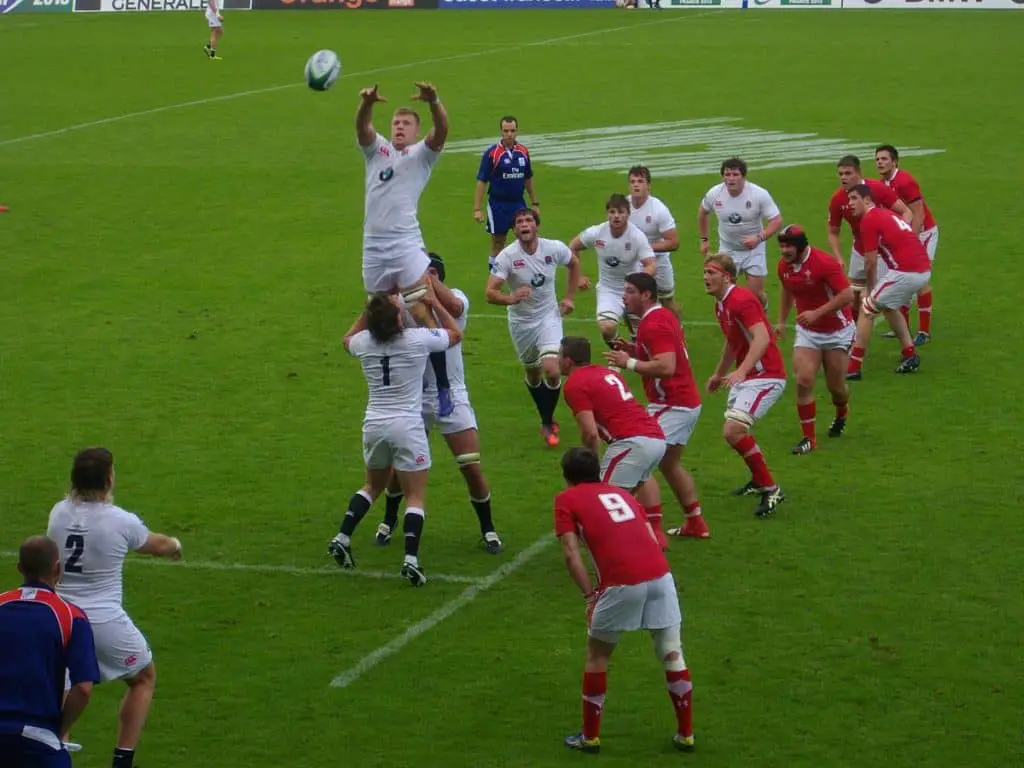On the referee’s assistants’ mark, each team forms a line of players beginning on the 5 meter line and stretching out to no further than the 15 meter line. The lines stand one meter apart and the ball is thrown down the middle for players to jump or be lifted into the air to compete for.
Lineout jumpers must not use their outside arm to knock the ball backwards, jump across the gap, or pull down an opponent whilst they are in the air. They can catch and pass the ball backwards to a teammate, usually the scrum-half, or they can tap the ball backwards instead.
The team throwing the ball-in decides how many players will be in the lineout with the minimum being 2 from either side and the maximum being 7 from either side. Jumpers may move backwards and forwards up and down the line in an attempt to gain an advantage in jumping for the ball.
The team throwing the ball in will have decided which player they are throwing the ball in to, and so can usually jump into the air at the right time to catch the ball before their opponents can react.

It should be noted that full contested lineouts don’t begin until Under 16 level for boys and Under 18 level for girls.
You might also like: Penalties and Free-kicks in Rugby A Basic Guide
Who does the lineouts in rugby?
Traditionally the hooker has the responsibility for throwing the ball into a lineout and the two second row players are the jumpers who take 60% of all lineout throws. The jumpers are usually lifted by the props and/or number eight and blindside flanker.
The openside flanker is usually left to roam free at the back of the lineout and clean up any loose ball.
Although the hooker throws the ball in usually anyone can actually do it and in bygone years the blindside winger was often the thrower in.
These days the blindside winger is not used as teams prefer to use them as an attacking weapon and it would leave a big space in the back field which could be kicked in if the lineout were lost.
Furthermore, throwing the ball into a lineout is not as easy as it looks. The hooker has to switch from a very physical aggressive role tackling opponents and scrummaging to all of a sudden standing stock still and having to perform a very delicate skill.
It is not just about throwing the ball accurately to the right space either, the timing has to be spot on. For example, if you hit the exact right spot a second late then the opposition may well have lifted their jumper into the space in front of your jumper and therefore steal the ball.
The co-ordination between the hooker, lifter and jumper has to be spot on and if any part of it goes wrong it can lead to a series of lost lineouts, a breakdown in confidence between the players not to mention a loss of trust between them.
If the opponents do get a sniff that confidence may be waning in their opponents lineout then they will likely put even more pressure on the jumpers and elect to kick for lineouts more and more in order to drive this advantage home.
This can cause a real problem for the team with the weaker lineout and the loss of much possession and consequently possibly of winning the game.
Rugby lineout positions and lifting
Step one
Squat down keeping your back straight and leaning forwards at about 45 degrees to the floor. The front lifter should place their hands underneath the blocks, or tape that the jumper should attach to their upper thighs. Check out specialist rugby tape that won’t fall off here.
The back lifter should place their hands under the buttocks of the jumper giving them plenty of cushion to push up on.
Step two
As the jumper jumps, fire up explosively through the legs and push up with the arms and shoulders adding to the momentum of the jump.
Step three
Once the jumper is elevated as high as possible into the air, squeeze in towards the other lifter and try to get your nose as close as you can to theirs all whilst keeping your back straight.
Step four
The jumper should be allowed to drop back down to the ground in just the same manner as anyone would when they land from a jump.
However, if the jumper takes a knock in the air then they may topple over on the way down and it is the lifters job to do whatever they can to ensure the players safety by either keeping them upright, or by lessening the impact of the fall.
Immediately after the player lands the lifters usually shield the jumper on either side before the ball is either moved away by the scrum-half or a maul is formed.
Recommended reading: Rugby Mauls Explained: A Basic Guide
Basic Rules of Quick Throw ins
Rather than setting up a 2-7 man lineout a quick throw in can be taken where a player can throw the ball in from anywhere between where touch was made and their own goal line. The ball must travel 5 metres and it must go laterally or backwards.
If an opposition player takes the ball into touch then they must release the ball immediately to allow their opponents the opportunity of a quick throw or risk a penalty. The same ball has to be used that went out of play, it must not be touched by any spectators before a quick throw is taken and a lineout must not already have been formed on the original touch mark.
The advantage of taking a quick throw is that it can get play going quicker and get the ball into space for attacking faster and the opposition may not have their defensive line set up and ready to defend at that time so it can be a very effective attacking weapon.
How many lineouts are there per game?
The average number of lineouts per game in international rugby is approximately 25 and the number of scrums 14 with an average ball in play time of 34 mins 21 seconds.
| World Cup | Scrum per game | Lineouts per game | Lineout win % | Ball in play time |
| 1987 | 32 | 45 | 68% | 28.11 |
| 1991 | 31 | 39 | 69% | 25.12 |
| 1995 | 23 | 37 | 73% | 26.43 |
| 1999 | 22 | 31 | 82% | 30.43 |
| 2003 | 22 | 34 | 80% | 31.58 |
| 2007 | 19 | 31 | 81% | 35.12 |
| 2011 | 17 | 24 | 82% | 32.12 |
| 2015 | 13 | 26 | 87% | 33.32 |
| 2019 | 14 | 25 | 91% | 34.21 |
This lineout number has decreased from over 30 pre 2011 when law changes caused a decrease in kicking for touch which leads to the increase in ball in play time in the table below which was supposed to make the game more attractive to fans.
Prior to 2011, teams could take the ball back into their own 22 meters area and kick the ball out and alineout would be taken from where the ball went out.
After 2011, rule changes meant that you could not take the ball back into you 22 meters area and kick the ball out. Well, you could, but the ineout would be taken from where you kicked it and not from where the ball went out.
This law was introduced to reduce the amount of kicking in the game and increase its entertainment value by forcing players to run more. It largely worked.
It should be noted that in the 1970 there could be in excess of 60 lineouts per game! Not great for television that’s for sure.
You might be interest in the basic rules of scrums here.
What age do you do lineouts in rugby?
Lineouts begin at Under 14 level in boys and girls rugby, however, the lineout is uncontested with no lifting allowed. Lifting is allowed at Under 15 level but remains uncontested. At Under 16 for Boys and Under 18 for girls full contested ineouts are permitted.
| Age Group | Lineout Progression |
| Boys and Girls Under 13 | No lineout |
| Boys Under 14 | Uncontested lineout introduced |
| Boy and Girls Under 15 | Uncontested lineout, lifting allowed |
| Boys Under 16 and Girls Under 18 and above | Full contested lineout |
Recommended for you: Age Grade Rule Progressions In Rugby (Tables and pdf)
References
Statsperform.com an array of match analysis stats
Image Credits
Wales win an uncontested lineout at Twickenham, in the 2004 en:Six Nations Championship User Gareth Owen on en.wikipedia, CC BY-SA 3.0, via Wikimedia Commons
